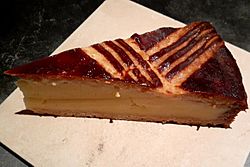Gâteau Basque facts for kids
 |
|
| Type | Pastry |
|---|---|
| Course | Dessert |
| Place of origin | France |
| Region or state | Northern Basque Country |
| Main ingredients | Almond flour, pastry cream or preserved cherries |
The Gâteau Basque (pronounced gah-toh bask) is a yummy traditional dessert from the Northern Basque Country in France. Its name in the Basque language is Etxeko bixkotxa, which means "cake of the house."
This special cake is usually filled with either a delicious black cherry jam or a creamy pastry cream. If you find a Gâteau Basque with cream, it's often from the Southern Basque Country in Spain.
Contents
What is Gâteau Basque?
Gâteau Basque is made from layers of a special cake dough. This dough is a type of butter-sugar pastry, often called pâte sablée. It's different from other doughs and gives the cake a unique texture.
The cake is usually filled with either a sweet black cherry jam or a smooth, creamy filling. This creamy filling is often an almond or vanilla pastry cream. Some people believe that only special black Xapata cherries, which grow in the Basque Country, should be used for the jam.
The Dough and Its Texture
The dough for Gâteau Basque is very important. It's a soft, shortbread-like dough, usually about 3 to 6 millimeters thick. The way the butter is mixed with the flour can change the dough's name and texture slightly.
If the butter is warmed before mixing, the dough is called pâte sucrée. If the butter is cold, it takes more work to mix, and the dough is called pâte sablée. This type of dough is a bit crumblier. Both methods create a delicious cake, but a very experienced taster might notice the small differences.
The flour used is a soft, refined wheat flour, perfect for cakes and pastries. The amount of sugar can also vary. After baking, the cake is often brushed with a shiny egg coating, making it look even more appealing.
Traditional Designs on Top
It's a tradition to put special designs on top of the Gâteau Basque. If the cake is filled with black cherry jam, you'll often see a Basque cross marked on the top. This cross is a symbol of the Basque region.
If the cake is filled with pastry cream, bakers usually create a crosshatch pattern on top. This means they make lines that cross each other, forming a grid-like design. These patterns help you know what's inside the cake!
The History of Gâteau Basque
The story of Gâteau Basque is closely connected to the town of Cambo-les-Bains in Labourd, France. It's thought that the cake might have started as a simpler bread called bistochak in the 1700s. Fishermen would even take it with them when they went out to sea!
The first person known to sell the cake commercially was Marianne Hirigoyen. She started selling it in Cambo in the early 1800s. Later, some versions of the cake were flavored with rum. This rum was brought back to France by Basque people who had traveled to the West Indies.
Celebrating the Cake Today
Today, the Gâteau Basque is so loved that there's even a special festival for it! The Gâteau Basque Festival (called Fête du Gâteau Basque) happens every year in Cambo-les-Bains. It's a fun event celebrating this delicious dessert.
There's also an organization called Eguzkia (which means "sun" in Basque). This group was started in France in 1994 to help promote high-quality Basque cakes. If you want to learn even more about the cake, you can visit Le musée du Gâteau Basque (The Museum of the Basque Cake) in Sare, Labourd. It's a whole museum dedicated to this one special cake!
See also
 In Spanish: Pastel vasco para niños
In Spanish: Pastel vasco para niños

